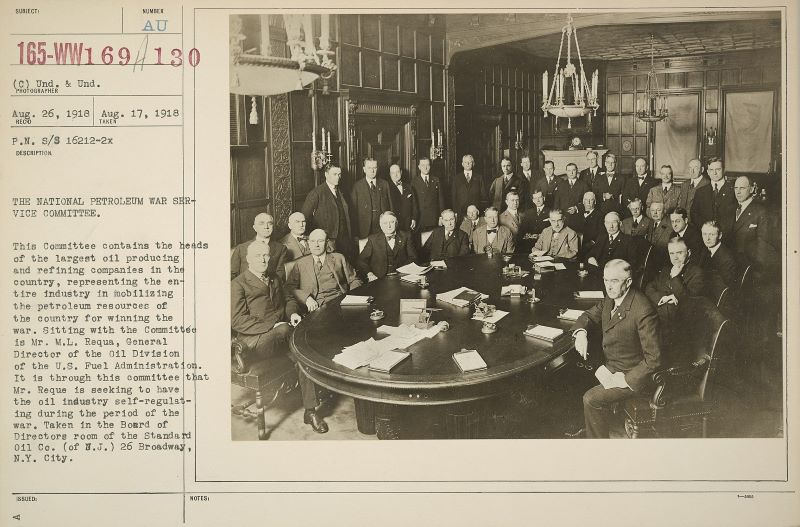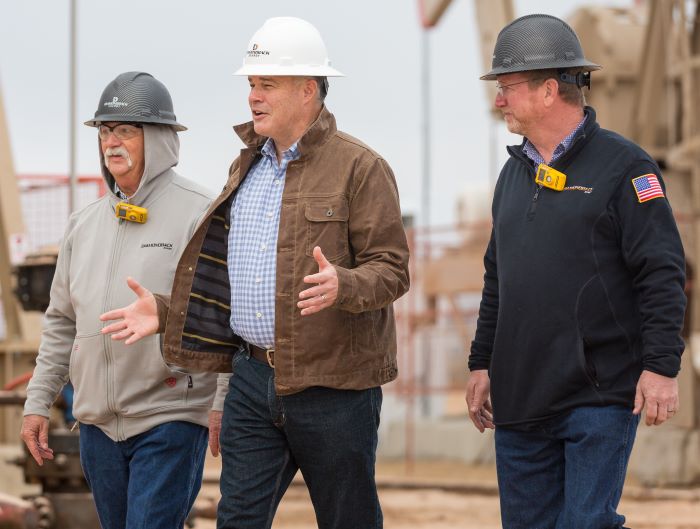API Standards at 100: A Century of Advancing Safety, Efficiency and Sustainability
— October 17, 2024.
As the world emerged from World War I, it became clear that global industrial expansion faced significant challenges. The world had been made “safe for democracy” as articulated by President Woodrow Wilson, at least for the time being, but not compatible across critical industries. In the oil business, operational inefficiencies – such as mismatched pipe sizes and equipment – revealed concerning vulnerabilities.
In 1919, API was founded primarily to help address such challenges, such as interchangeability of equipment from different suppliers, and in 1924 – 100 years ago on Sunday – API published its first standard: Specifications for Steel and Iron Pipe for Oil Country Tubular Goods.

The seeds of API were planted as the industry supported America’s World War I effort.
The standard addressed immediate operational issues, and it also set the stage for API’s century-long commitment to improving safety, efficiency and sustainability across the energy sector. Over the past 100 years, API has delivered on this mission, developing more than 800 standards that have shaped global energy practices and advanced the industry’s ability to innovate and meet evolving demands and challenges.
A Framework for Success
API’s longevity has not been a matter of chance. Its success is rooted in its structured and inclusive standards development process, which today is accredited by the American National Standards Institute. This rigorous process ensures that API’s standards are technically sound and are adopted by stakeholders from across the industry and governments in the U.S. and around the globe.
The entire process is consensus-based, which allows for multiple perspectives to be heard and included. By involving industry representatives, regulators, academia and public stakeholders, API fosters a collaborative environment that leads to technically sound standards that also create trust and acceptance.

API committee members collaborate toward consensus in developing rigorous standards.
Embracing Innovation and Technology
Throughout the past century, API’s standards have continually evolved to address new technologies, operational complexities and emerging challenges. While API’s standards portfolio began by detailing pipe specifications, today it has expanded to address societal concerns, such as community engagement and environmental protection.
An example of the latter is API's work on public engagement (API RP 1185, Pipeline Public Engagement), which provides guidelines for enhancing two-way public engagement throughout the entire pipeline lifecycle – everything from early siting conversations through construction, operations, and decommissioning. By fostering transparent and genuine interactions, the standard builds trust and strengthens relationships between pipeline operators and stakeholders (including government at all levels: local, state, federal, or tribal), helping contribute to safer and more reliable pipeline operations.
Due to the dynamic nature of the industry, including the constant development of new equipment and technologies, there is a growing need for new standards. As a result, API currently has 81 first-edition standards in development – roughly one-third of its active standards projects (the remaining standards cover updates to existing standards). These cover emerging topics and fields like repair and remanufacture and emerging technologies.

API President and CEO Mike Sommers (middle) in Midland, Texas. API standards help ensure safe operations.
Navigating the Path to Low-Carbon Operations
As the global energy industry faces the dual challenge of providing reliable, affordable energy while advancing climate goals, API is playing a key role. Over the past three years, API has published nearly 60 standards directly contributing to reductions in greenhouse gas emissions, flaring and leak detection, demonstrating its commitment to addressing climate change.
API is also leading efforts to develop standards for emerging low-carbon technologies such as carbon capture and storage (CCS) and hydrogen infrastructure. For example, API is developing a new Recommended Practice (RP) providing guidelines for carbon dioxide (CO2) transportation pipelines, supporting the safe and reliable deployment of CCS projects. Additionally, the API RP 75W standard for offshore wind helps promote safety and environmental management in renewable energy projects.
Shaping the Future of Energy
As the world’s energy landscape continues to evolve, the challenges facing the industry are more complex than ever before. Whether it’s updating standards related to repair and remanufacture or advancing new safety guidelines for alternative energies, success requires technical expertise, innovation and collaboration. With 100 years of demonstrated success, API is uniquely positioned to lead the way into the next century, enhancing our industry’s safety, efficiency and environmental stewardship as it provides the leading energy sources for America and the world.
API represents all segments of America’s natural gas and oil industry, which supports nearly 11 million U.S. jobs and is backed by a growing grassroots movement of millions of Americans. Our approximately 600 members produce, process and distribute the majority of the nation’s energy, and participate in API Energy Excellence®, which is accelerating environmental and safety progress by fostering new technologies and transparent reporting. API was formed in 1919 as a standards-setting organization and has developed more than 800 standards to enhance operational and environmental safety, efficiency and sustainability.
FOLLOW OUR SOCIAL MEDIA: